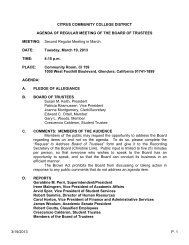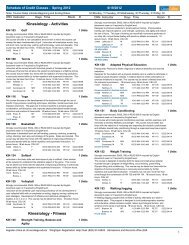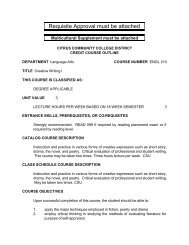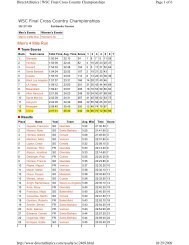Bid #01-1112 Library and Reprographics Roofing ... - Citrus College
Bid #01-1112 Library and Reprographics Roofing ... - Citrus College
Bid #01-1112 Library and Reprographics Roofing ... - Citrus College
You also want an ePaper? Increase the reach of your titles
YUMPU automatically turns print PDFs into web optimized ePapers that Google loves.
ase ply surface <strong>and</strong> up the primed wall or curb to the desired flashing height. After the final<br />
roofing ply has been applied to the top of the cant, prepare the surface area that is to<br />
receive flashing coverage by torch heating granular surfaces or by application of asphalt<br />
primer; allowing primer to dry thoroughly. Torch apply the metal foil-faced flashing into place<br />
using three foot widths (cut off the end of roll) always lapping the factory selvage edge.<br />
Stagger the laps of the metal foil flashing layer from lap seams in the reinforcing layer.<br />
Extend the flashing sheet a minimum of 4 inches beyond the toe of the cant onto the<br />
prepared surface of the finished roof <strong>and</strong> up the wall or curb to the desired flashing height.<br />
Exert pressure on the flashing sheet during application to ensure complete contact with the<br />
vertical/horizontal surfaces, preventing air pockets; this can be accomplished by using a<br />
damp sponge or shop rag. Check <strong>and</strong> seal all loose laps <strong>and</strong> edges. Nail the top edge of<br />
the flashing on 9 inch centers. (See manufacturer's schematic for visual interpretation).<br />
K. Loose Chip Removal: Broom the surface of the finish ply in both machine <strong>and</strong> crossmachine<br />
direction using a stiff nylon bristle broom. Remove excess chips from the roof<br />
area.<br />
L. Water Cut-Off: At end of day's work, or when precipitation is imminent, construct a water<br />
cut-off at all open edges. Cut-offs can be built using asphalt or plastic cement <strong>and</strong> roofing<br />
felts, constructed to withst<strong>and</strong> protracted periods of service. Cut-offs must be completely<br />
removed prior to the resumption of roofing.<br />
3.06 MIXING OF RESIN PRODUCTS<br />
A. Preparation/Mixing/Catalyzing Resin Products: Pour the desired quantity of resin into a<br />
clean container <strong>and</strong> using a spiral mixer or mixing paddle, stir the liquid for the time period<br />
specified by the resin manufacturer. Calculate the amount of catalyst powder needed using<br />
the manufacturer's guidelines <strong>and</strong> add the pre-measured catalyst to the resin component.<br />
Mix again for the time period specified by the resin manufacturer, ensuring that the product<br />
is free from swirls <strong>and</strong> bubbles. Ensure that air is not entrained into the product during the<br />
mixing process. To avoid aeration, do not use a spiral mixer unless the spiral section of the<br />
mixer can be fully contained in the liquid during the mixing process. Mix only enough<br />
product to ensure that it can be applied before expiration of resin pot life.<br />
3.07 RESIN FLASHING AND FIELD MEMBRANE APPLICATION<br />
A. Base Flashing Application<br />
1. Using masking tape, mask the perimeter of the area to receive the flashing system.<br />
Apply resin primer to substrates requiring additional preparation <strong>and</strong> allow primer to set.<br />
2. Pre-cut fleece to ensure a proper fit at transitions <strong>and</strong> corners prior to membrane<br />
application.<br />
3. Apply an even, generous base coat of flashing resin using a roller at the minimum rate<br />
specified by the resin manufacturer to prepared surfaces requiring flashing coverage.<br />
Work the fleece into the wet, catalyzed resin using a brush or roller to fully embed the<br />
fleece in the resin <strong>and</strong> remove trapped air. Lap fleece layers a minimum of 2 inch (5 cm)<br />
<strong>and</strong> apply an additional coat of catalyzed resin between layers of overlapping fleece.<br />
Again using a roller, apply an even top coat of catalyzed resin at the minimum rate<br />
specified by the resin manufacturer immediately following embedment of the fleece,<br />
M-13-135 page - 19 <strong>Citrus</strong> <strong>Reprographics</strong> <strong>Roofing</strong> Specification
















